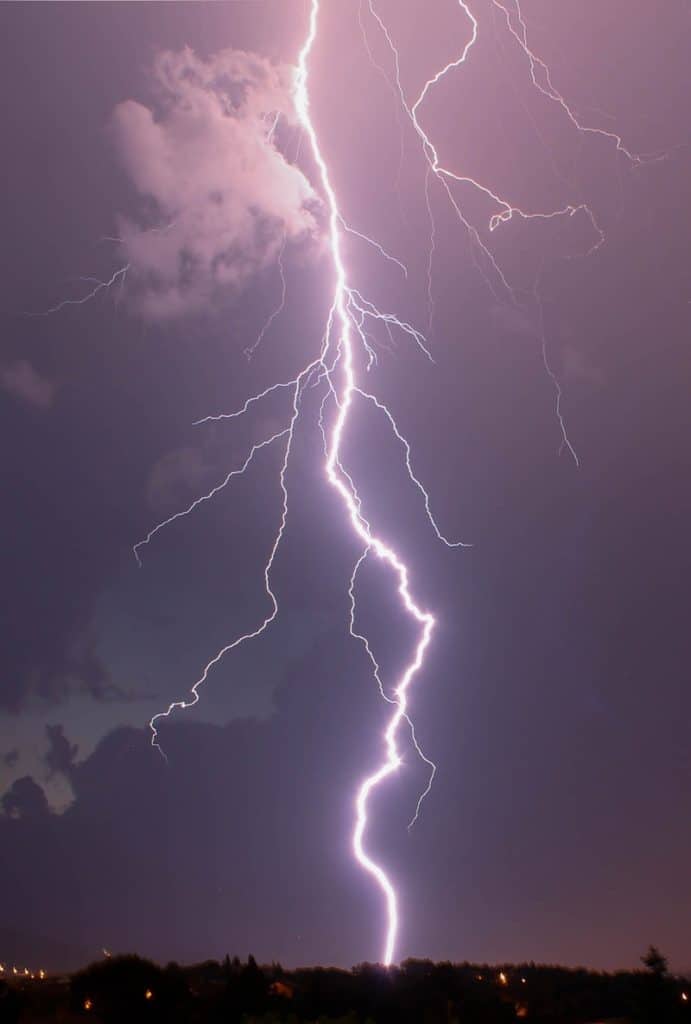
Your general risk of being struck by lightning is about 1/700,000 per year. About 10% of strikes result in death. Of course, that risk can go way up or down depending on a person’s behavior.
The specific lightning we are concerned with is generated by an electrical potential between a storm cloud and the earth. This potential results in a discharge of electric current between the negative ions in the cloud and positive charge on earth. As a storm moves along, it generates more electrical force, drawing positive energy up from the earth through tall objects. So it makes sense to avoid being the tallest object or being on the tallest object if you want to avoid a strike.
This potential averages about 30 million volts, but may be as high as 100 million, lasting 30 milliseconds. A lightning flash is made of about 4 of these strokes, hence the flicker of lightning.
The lightning stroke is about one inch in diameter and heats the surrounding air up to about 50,000 degrees Fahrenheit – four times as hot as the surface of the sun! This sudden heating and therefore explosive expansion of air, causes a shock wave that is heard as thunder.
This shock wave can throw a person a fair distance resulting in blunt trauma. A lightning strike can travel up to 10 miles horizontally in front of a thunderstorm, and the average lightning flash travels 6 miles before touching the earth.
As you can imagine, being in contact with a 100 million volts can result in injury or death for several reasons. First, if struck directly, a massive current runs through the victim resulting in internal burns, organ damage, nerve damage, cardiac arrest, and most often death.
Other ways of being struck include: splash – where lightning hits a nearby object then bounces to the victim, contact – energy passes within a conductive material that is struck, then to the victim, such as an umbrella, and lastly, blunt trauma is a result of being thrown by the shock wave.
Indirect strikes are much more common, and include being struck by ground charge which is the positive current running in the ground toward the strike, which then takes a path through the victim because they offer lower resistance. Sometimes, the current passes over the body rather than through it and this results in characteristic burn patterns.
This difference in energy potential in the ground is why you don’t want to be laying down in a lightning storm. The farther your body is spread out on the ground, the more likely you will be injured (due to increased electrical potential). Rubber boots or a sleeping mat will not help.
Consider following the 30/30 rule: if you can hear thunder within 30 seconds of a lightning flash, then stay in a sheltered area. Remain there for 30 minutes after the last crack of thunder. Sheltered areas include buildings with plumbing/electrical to dissipate the charge not tents or outhouses. If you are stuck outside, squat down with your feet together in an open area with low elevation. Don’t hold an umbrella.
When responding to a lightning victim, remember your safety is paramount. You are safe in the ambulance. It is likely the storm will have already passed by the time you arrive since most storms move at about 25 mi/hour, but be aware that a receding storm still poses risk if you can still hear thunder within 30 seconds of a lightning flash.
Remember a victim is safe to touch – they don’t hold a charge. Treat life threats and assess/treat ABCs. A lightning strike is not a contraindication to using an AED if needed, but get the patient out of any standing water.
Always provide C-spine immobilization as many of these victims sustained trauma from being thrown. This is a high priority transport. Call for ALS if available as lightning strike patients can sustain unsuspected heart damage that could result in arrhythmias.
The specific lightning we are concerned with is generated by an electrical potential between a storm cloud and the earth. This potential results in a discharge of electric current between the negative ions in the cloud and positive charge on earth. As a storm moves along, it generates more electrical force, drawing positive energy up from the earth through tall objects. So it makes sense to avoid being the tallest object or being on the tallest object if you want to avoid a strike.
This potential averages about 30 million volts, but may be as high as 100 million, lasting 30 milliseconds. A lightning flash is made of about 4 of these strokes, hence the flicker of lightning.
The lightning stroke is about one inch in diameter and heats the surrounding air up to about 50,000 degrees Fahrenheit – four times as hot as the surface of the sun! This sudden heating and therefore explosive expansion of air, causes a shock wave that is heard as thunder.
This shock wave can throw a person a fair distance resulting in blunt trauma. A lightning strike can travel up to 10 miles horizontally in front of a thunderstorm, and the average lightning flash travels 6 miles before touching the earth.
As you can imagine, being in contact with a 100 million volts can result in injury or death for several reasons. First, if struck directly, a massive current runs through the victim resulting in internal burns, organ damage, nerve damage, cardiac arrest, and most often death.
Other ways of being struck include: splash – where lightning hits a nearby object then bounces to the victim, contact – energy passes within a conductive material that is struck, then to the victim, such as an umbrella, and lastly, blunt trauma is a result of being thrown by the shock wave.
Indirect strikes are much more common, and include being struck by ground charge which is the positive current running in the ground toward the strike, which then takes a path through the victim because they offer lower resistance. Sometimes, the current passes over the body rather than through it and this results in characteristic burn patterns.
This difference in energy potential in the ground is why you don’t want to be laying down in a lightning storm. The farther your body is spread out on the ground, the more likely you will be injured (due to increased electrical potential). Rubber boots or a sleeping mat will not help.
Consider following the 30/30 rule: if you can hear thunder within 30 seconds of a lightning flash, then stay in a sheltered area. Remain there for 30 minutes after the last crack of thunder. Sheltered areas include buildings with plumbing/electrical to dissipate the charge not tents or outhouses. If you are stuck outside, squat down with your feet together in an open area with low elevation. Don’t hold an umbrella.
When responding to a lightning victim, remember your safety is paramount. You are safe in the ambulance. It is likely the storm will have already passed by the time you arrive since most storms move at about 25 mi/hour, but be aware that a receding storm still poses risk if you can still hear thunder within 30 seconds of a lightning flash.
Remember a victim is safe to touch – they don’t hold a charge. Treat life threats and assess/treat ABCs. A lightning strike is not a contraindication to using an AED if needed, but get the patient out of any standing water.
Always provide C-spine immobilization as many of these victims sustained trauma from being thrown. This is a high priority transport. Call for ALS if available as lightning strike patients can sustain unsuspected heart damage that could result in arrhythmias.


